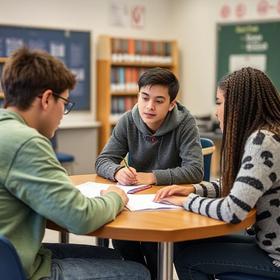Serving 240 students in grades Kindergarten-2, Post Franklin School ranks in the bottom 50% of all schools in Michigan for overall test scores (math proficiency is bottom 50%, and reading proficiency is bottom 50%).
The percentage of students achieving proficiency in math is 10-14% (which is lower than the Michigan state average of 38%). The percentage of students achieving proficiency in reading/language arts is 10-14% (which is lower than the Michigan state average of 50%).
The student-teacher ratio of 16:1 is lower than the Michigan state level of 17:1.
Minority enrollment is 77% of the student body (majority Black), which is higher than the Michigan state average of 37% (majority Black and Hispanic).
Quick Facts (2025-26)
- Grades: Kindergarten-2
- Enrollment: 240 students
- Student-Teacher Ratio: 16:1
- Minority Enrollment: 77%
- Math Proficiency: 10-14%
- Reading Proficiency: 10-14%
- Source: National Center for Education Statistics (NCES), MI Dept. of Education
Top Rankings
Post Franklin School ranks among the top 20% of public schools in Michigan for:
Category
Attribute
Diversity
Percent Eligible For Free Lunch
School Overview
Post Franklin School's student population of 240 students has declined by 16% over five school years.
The teacher population of 15 teachers has declined by 11% over five school years.
Grades Offered
Grades Kindergarten-2
(No virtual instruction)
(No virtual instruction)
Total Students
240 students
Gender %
Total Classroom Teachers
15 teachers
Year Founded
1905
School Calendar
Campus Size
441 acres
School Motto
100% Success for every Post-Franklin student
School Rankings
The diversity score of Post Franklin School is 0.72, which is more than the diversity score at state average of 0.56. The school's diversity has stayed relatively flat over five school years.
Math Test Scores (% Proficient)
(15-16)10-14%
38%
Reading/Language Arts Test Scores (% Proficient)
(15-16)10-14%
50%
Student-Teacher Ratio
16:1
17:1
American Indian
n/a
1%
Asian
1%
4%
Hispanic
17%
9%
Black
41%
18%
White
23%
63%
Hawaiian
n/a
n/a
Two or more races
18%
5%
All Ethnic Groups
Participates in the National School Lunch Program (NSLP)
Yes
Eligible for Free Lunch
87%
50%
Eligible for Reduced Lunch
5%
4%
School Statewide Testing
School District Name
Source: National Center for Education Statistics (NCES), MI Dept. of Education
Profile last updated: 02/09/2025
Frequently Asked Questions
What percent of students have achieved state testing proficiency in math and reading?
10-14% of students have achieved math proficiency (compared to the 38% MI state average), while 10-14% of students have achieved reading proficiency (compared to the 50% MI state average).
How many students attend Post Franklin School?
240 students attend Post Franklin School.
What is the racial composition of the student body?
41% of Post Franklin School students are Black, 23% of students are White, 18% of students are Two or more races, 17% of students are Hispanic, and 1% of students are Asian.
What is the student-teacher ratio of Post Franklin School?
Post Franklin School has a student ration of 16:1, which is lower than the Michigan state average of 17:1.
What grades does Post Franklin School offer ?
Post Franklin School offers enrollment in grades Kindergarten-2 (No virtual instruction).
What school district is Post Franklin School part of?
Post Franklin School is part of Battle Creek Public Schools.
School Reviews
Review Post Franklin School. Reviews should be a few sentences in length. Please include any comments on:
- Quality of academic programs, teachers, and facilities
- Availability of music, art, sports and other extracurricular activities
Recent Articles

Public School Choice, Magnet Programs & Charter Options — What’s Best?
Explore public school choice in 2025: comparing magnet programs, charter schools and traditional public schools to find what’s best for your child.

The Role of Support Services in Public Schools: Tutoring, Counseling & More
Explore how tutoring, counseling and comprehensive support services enhance student success in public schools, with 2025 insights for educators, parents and students.

The Impact of Social Media on Students – 2025 Updated Insights
Explore how social media affects students’ academic performance, behaviour and wellbeing in 2025 with expert insights and policy updates.





